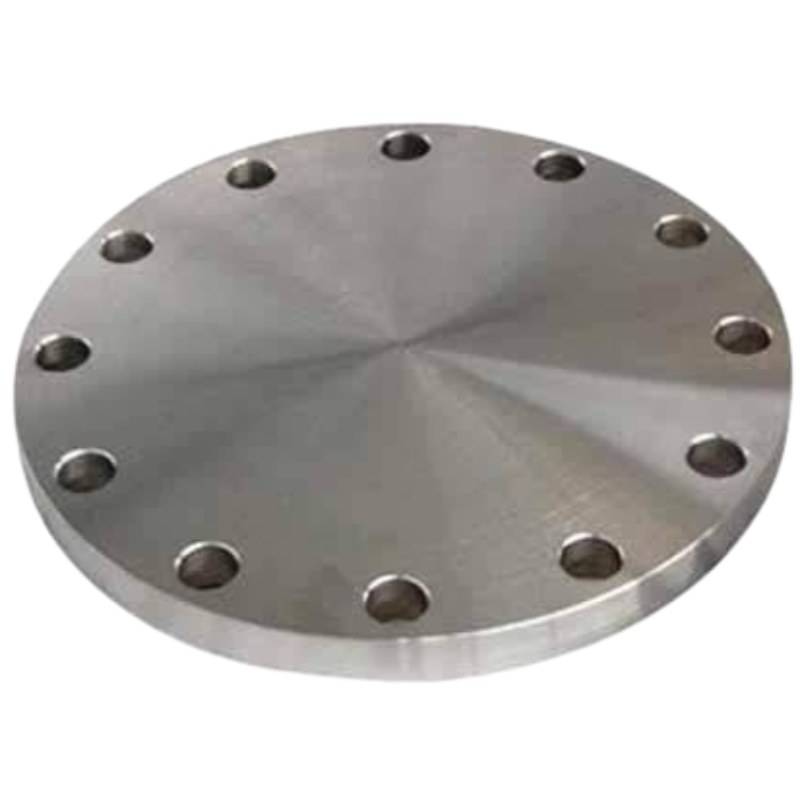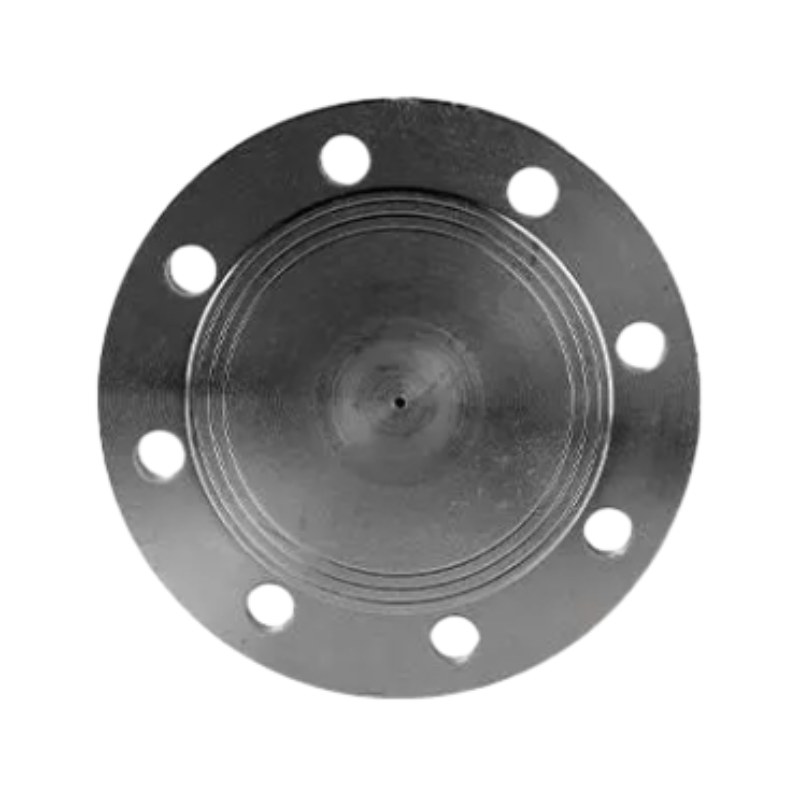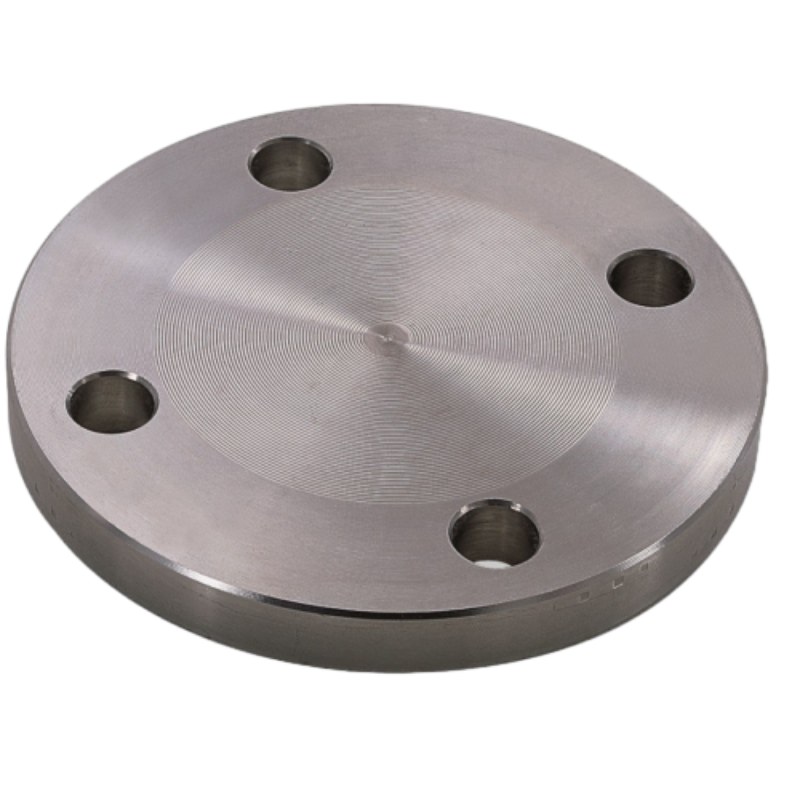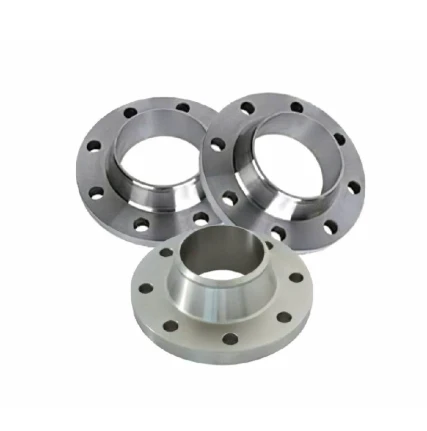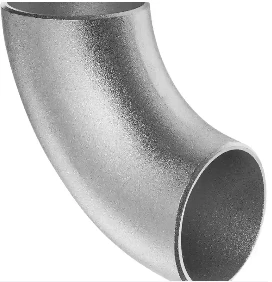-
DIN2527 நிலையான இணக்கம்:
DIN2527 குருட்டு விளிம்புகள் Deutsches Institut für Normung (DIN) மூலம் கோடிட்டுக் காட்டப்பட்டுள்ள விவரக்குறிப்புகளுக்கு இணங்குகின்றன, மற்ற DIN-இணக்கமான கூறுகளுடன் சீரான தன்மை மற்றும் இணக்கத்தன்மையை உறுதி செய்கிறது. இந்த தரப்படுத்தல் குழாய் அமைப்புகளில் குருட்டு விளிம்புகளை ஒருங்கிணைப்பதை எளிதாக்குகிறது, தடையற்ற செயல்பாடு மற்றும் பராமரிப்பை ஊக்குவிக்கிறது. - சீல் செய்யப்பட்ட மூடல்:
குருட்டு விளிம்புகள் ஒரு குழாய் அமைப்பில் குழாய் முனைகள் அல்லது திறப்புகளை சீல் செய்வதற்கான இன்றியமையாத செயல்பாட்டைச் செய்கின்றன. DIN2527 குருட்டு விளிம்புகள் ஒரு திடமான, தட்டையான வட்டு சுற்றளவைச் சுற்றி போல்ட் துளைகளைக் கொண்டவை, அவை இனச்சேர்க்கை விளிம்பு அல்லது குழாய் முனையில் பாதுகாப்பாக போல்ட் செய்ய அனுமதிக்கிறது. இந்த சீல் செய்யப்பட்ட மூடல் திரவங்கள் அல்லது வாயுக்களின் கசிவைத் தடுக்கிறது, குழாய் அமைப்பின் ஒருமைப்பாடு மற்றும் பாதுகாப்பைப் பராமரிக்கிறது. -
பல்துறை பயன்பாடுகள்:
எண்ணெய் மற்றும் எரிவாயு, இரசாயன செயலாக்கம், நீர் சுத்திகரிப்பு, மின் உற்பத்தி மற்றும் கப்பல் கட்டுதல் உள்ளிட்ட பல்வேறு தொழில்களில் DIN2527 குருட்டு விளிம்புகள் பயன்படுத்தப்படுகின்றன. அவை பைப்லைன்கள், அழுத்தக் கப்பல்கள் மற்றும் சேமிப்பு தொட்டிகளில் பயன்படுத்தப்படாத அல்லது தற்காலிக திறப்புகளைத் தடுக்க, பராமரிப்பு அல்லது பழுதுபார்ப்பதற்காக குழாய்களின் பிரிவுகளை தனிமைப்படுத்த அல்லது ஆய்வு மற்றும் சோதனைக்கான வழிமுறையாகப் பயன்படுத்தப்படுகின்றன. -
பொருள் தேர்வு:
குருட்டு விளிம்புகள் வெவ்வேறு இயக்க நிலைமைகள் மற்றும் ஊடகங்களுக்கு ஏற்றவாறு பல்வேறு பொருட்களில் கிடைக்கின்றன. பொதுவான பொருட்களில் கார்பன் எஃகு, துருப்பிடிக்காத எஃகு, அலாய் ஸ்டீல் மற்றும் பித்தளை அல்லது வெண்கலம் போன்ற இரும்பு அல்லாத உலோகக் கலவைகள் அடங்கும். பொருளின் தேர்வு வெப்பநிலை, அழுத்தம், அரிப்பு எதிர்ப்பு மற்றும் கையாளப்படும் திரவம் அல்லது வாயுவுடன் இணக்கம் போன்ற காரணிகளைப் பொறுத்தது. -
அழுத்த மதிப்பீடுகள்:
DIN2527 குருட்டு விளிம்புகள் DIN தரநிலைகளின்படி PN6 முதல் PN100 வரையிலான குறிப்பிட்ட அழுத்த மதிப்பீடுகளைத் தாங்கும் வகையில் வடிவமைக்கப்பட்டுள்ளன. அழுத்த மதிப்பீடு அதன் கட்டமைப்பு ஒருமைப்பாடு அல்லது சீல் செயல்திறனை சமரசம் செய்யாமல் ஃபிளேன்ஜ் பாதுகாப்பாக தாங்கக்கூடிய அதிகபட்ச அனுமதிக்கக்கூடிய அழுத்தத்தை ஆணையிடுகிறது. பாதுகாப்பான மற்றும் நம்பகமான செயல்பாட்டை உறுதிப்படுத்த, நோக்கம் கொண்ட பயன்பாட்டிற்கான பொருத்தமான அழுத்த மதிப்பீட்டைக் கொண்ட குருட்டு விளிம்புகளைத் தேர்ந்தெடுப்பது அவசியம். -
தனிப்பயனாக்குதல் விருப்பங்கள்:
While DIN2527 blind flanges conform to standard dimensions and specifications, customization options are available to accommodate unique project requirements. This may include variations in flange size, facing type (such as flat face or raised face), bolt-hole pattern, and special coatings or treatments for enhanced corrosion resistance. Customized blind flanges are often tailored to fit specific piping configurations and operating conditions.
What Is a Blind Flange?
A blind flange is a solid, circular plate used to seal off the ends of piping systems, valves, or pressure vessels. Unlike other different flange types, blind flanges lack a central bore, making them ideal for completely closing off a pipeline or opening. They are commonly utilized in various industrial applications, including oil and gas, chemical processing, water treatment, and power generation, where secure and leak-proof pipe closures are essential.
Blind flanges are available in a wide range of sizes and pressure ratings, conforming to industry standards such as ANSI, ASME, and DIN. Sizes range from small diameters, like a 2-inch blind flange, to larger options, such as 36 blind flanges, catering to diverse operational requirements. The design typically features bolt holes around the perimeter, allowing the flange to be securely fastened to a mating component, like a pipe flange or valve.
The primary purpose of a blind flange is to isolate sections of a pipeline for maintenance, testing, or system modifications without disrupting the entire operation. They also play a critical role in pressure testing, allowing operators to evaluate the system's capacity under specific conditions.
Materials for blind flanges include stainless steel, carbon steel, alloy steel, and other metals, ensuring compatibility with various operating environments, including high-temperature, high-pressure, or corrosive conditions. Some blind flanges also feature coatings or linings for additional durability.
Blind flanges are essential for ensuring safety, system integrity, and operational flexibility. Their robust design and adaptability make them indispensable in industrial piping systems, providing reliable sealing solutions and enhancing overall efficiency.
What Is a Blind Flange Used For
Pipeline Isolation
Blind flanges are commonly used to isolate sections of a pipeline for maintenance, repairs, or system upgrades. By sealing off the pipeline, operators can work on specific sections without interrupting the entire operation.
System Testing
In pressure testing scenarios, blind flanges enable operators to assess the strength and performance of the pipeline or vessel under controlled conditions. The flange helps maintain pressure within the system during testing, ensuring accurate results.
Future Expansion
Blind flanges can be installed at pipeline terminations where future expansions are anticipated. They temporarily seal the system, allowing additional components to be integrated later without significant modifications.
Safety in Shutdowns
During system shutdowns, blind flanges ensure that no residual fluids or gases escape, enhancing safety for maintenance crews and protecting the environment.
Preventing Contamination
In industries like food processing or pharmaceuticals, blind flanges are used to prevent contamination by securely sealing unused pipeline sections.
Blind Flange Types
Standard Blind Flanges
Standard blind flanges are flat, solid discs with no central bore. They are designed to fit a variety of piping systems and are often categorized by standards such as ANSI, ASME, and DIN. These flanges are versatile and used in applications with moderate pressure and temperature conditions.
Raised Face (RF) Blind Flanges
Raised face blind flanges feature a slightly elevated sealing surface. The raised face provides a better seal when paired with gaskets, making them suitable for higher-pressure applications in industries like oil and gas.
Flat Face (FF) Blind Flanges
Flat-face blind flanges have a uniform sealing surface that lies flush with the pipe flange. They are ideal for systems where flange surfaces must be evenly distributed to prevent damage, such as in low-pressure environments.
Ring-Type Joint (RTJ) Blind Flanges
RTJ blind flanges feature a grooved surface to accommodate metal gaskets. This design provides superior sealing, making them ideal for high-pressure and high-temperature systems, such as petrochemical plants.
Threaded Blind Flanges
Threaded blind flanges have threads on their inner surface, allowing them to be screwed directly onto a threaded pipe. They are commonly used in low-pressure systems and applications requiring quick assembly and disassembly.
DIN 2527 Blind Flange Advantages
The DIN 2527 blind flange is an essential component in piping systems, particularly in industrial applications where robust sealing is required. This type of flange offers several advantages, making it a preferred choice for many engineers and designers.
Firstly, one of the main benefits of the DIN 2527 blind flange is its ability to provide a secure and leak-proof seal. By covering the ends of pipes, it effectively blocks the flow, preventing any unwanted leaks or exposures. This is particularly critical in systems that transport hazardous materials, where safety and environmental protection are of utmost importance.
Secondly, the DIN 2527 blind flange is designed to withstand high pressure and temperature conditions, which ensures durability and long service life. Constructed from various materials, including stainless steel, carbon steel, and alloys, these flanges can be tailored to meet specific operational requirements, enhancing their reliability under extreme conditions.
Another advantage is the easy installation process. The blind flange can be easily bolted to the end of a pipe without requiring any special tools or complex techniques. This simplifies the assembly process and allows for quicker maintenance or modifications in the future.
Additionally, blind flanges are highly versatile and can be used in a range of applications, from oil and gas to water treatment and chemical processing. This versatility makes the DIN 2527 blind flange an excellent solution for diverse industries.
Moreover, using blind flanges can enhance the system's overall design by facilitating future expansions or modifications. Since they can be removed and replaced without extensive alterations to the piping layout, they provide flexibility in system management.
In summary, the DIN 2527 blind flange offers secure sealing, durability, ease of installation, versatility, and design flexibility, making it a vital component in many industrial piping systems. Its advantages contribute significantly to operational efficiency and safety, solidifying its status as a preferred choice in various applications.
DIN2527 குருட்டு விளிம்புகள் குழாய் அமைப்புகளில் இன்றியமையாத கூறுகள், குழாய் முனைகள் அல்லது திறப்புகளுக்கு நம்பகமான மற்றும் கசிவு-ஆதார மூடுதலை வழங்குகிறது. டிஐஎன் தரநிலைகள், பல்திறன் மற்றும் தனிப்பயனாக்கக்கூடிய விருப்பங்களை அவர்கள் கடைபிடிப்பது, இறுக்கமான சீல் மற்றும் அழுத்தத்தைக் கட்டுப்படுத்துவது முக்கியமானதாக இருக்கும் பரந்த அளவிலான தொழில்துறை பயன்பாடுகளுக்கு ஏற்றதாக அமைகிறது. DIN2527 கண்மூடித்தனமான விளிம்புகளுடன், பொறியாளர்கள் மற்றும் ஆபரேட்டர்கள் தங்கள் குழாய் அமைப்புகளின் ஒருமைப்பாடு, பாதுகாப்பு மற்றும் செயல்திறனை உறுதிப்படுத்த முடியும், இது தொழில்கள் முழுவதும் மென்மையான மற்றும் சிக்கல் இல்லாத செயல்பாடுகளுக்கு பங்களிக்கிறது.







